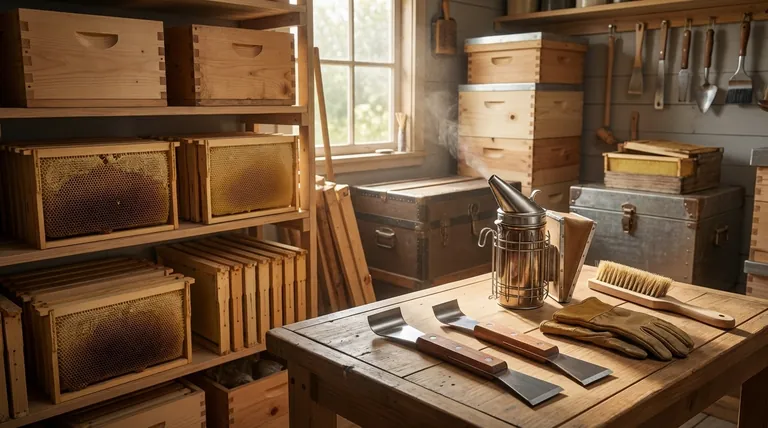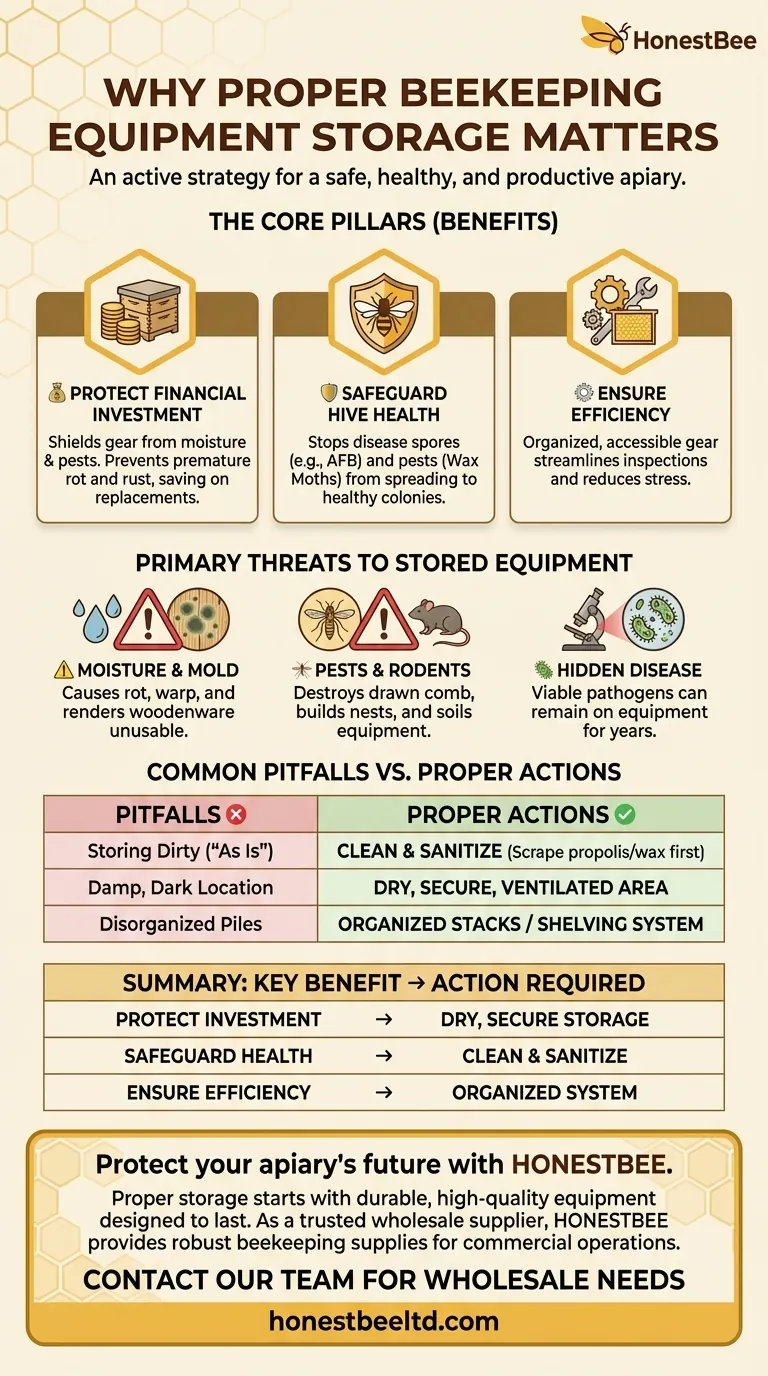At its core, properly storing beekeeping equipment is a critical practice that directly impacts your financial investment, the health of your bees, and your overall efficiency as a beekeeper. It saves you money on replacements, prevents the spread of devastating diseases, and ensures your gear is protected and ready when you need it.
Proper storage is not a passive chore but an active management strategy. It transforms your equipment from a potential liability into a reliable asset that supports a safe, healthy, and productive apiary.

The Core Pillars of Equipment Storage
Understanding the "why" behind equipment storage comes down to three fundamental benefits: protecting your investment, safeguarding your bees, and streamlining your work.
Protecting Your Financial Investment
Beekeeping equipment represents a significant cost. Hive bodies, frames, and specialized tools are all susceptible to damage when not stored correctly.
Proper storage shields this gear from the primary threats of moisture and pests. An organized, protected space prevents wood from rotting, metal from rusting, and foundation from being destroyed, maximizing the lifespan of every component.
Safeguarding Hive Health
This is the most critical reason for proper storage. Old equipment can be a reservoir for pests and pathogens that can devastate a healthy colony.
Pests like wax moths can completely destroy drawn comb in storage. More importantly, microscopic disease spores can remain viable on old equipment for years. Storing gear without first cleaning and sanitizing it is one of the fastest ways to spread disease throughout your apiary.
Ensuring Operational Efficiency
A dedicated and organized storage area makes the task of beekeeping far less stressful and much more effective.
When your equipment is clean, easy to find, and located conveniently near your hives, you can respond to the needs of your bees quickly. This prevents frantic searches for a needed frame or tool during a critical hive inspection.
The Primary Threats to Stored Equipment
Failing to store equipment properly exposes it to several distinct and preventable threats, each with significant consequences for your bees and your budget.
Damage from Moisture
Wood is highly susceptible to moisture. Equipment left exposed to the elements or stored in a damp basement will absorb water, leading to rot, warp, and mold. This damage can render expensive woodenware completely unusable.
Infestations from Pests
Aside from bees, your equipment is highly attractive to other creatures. Wax moths will lay eggs in stored comb, and their larvae will tunnel through and destroy it. Rodents will chew through wood and build nests inside hive bodies, soiling everything.
The Hidden Danger of Disease
Used equipment can harbor spores from diseases like American Foulbrood (AFB) or Chalkbrood. If you place a new, healthy colony into a hive body that wasn't properly sanitized, you risk a catastrophic outbreak that can wipe out the colony and spread to others.
Common Pitfalls to Avoid
Many well-intentioned beekeepers make simple mistakes that undermine their efforts. Being aware of these common pitfalls is the first step to establishing a better system.
Storing Equipment "As Is"
The single biggest mistake is putting away dirty equipment. Scrape off all propolis and wax before storage. Any frames with signs of disease should be destroyed, not stored, and all other components should be sanitized according to best practices.
Choosing the Wrong Location
A damp, dark basement is a breeding ground for mold and mildew. An unsecured shed or barn invites rodents and other pests. The ideal location is dry, secure, and has good ventilation.
Creating Disorganized Piles
Simply stacking equipment in a corner creates problems. It makes it impossible to inspect for pests, prevents air circulation which can trap moisture, and makes finding what you need a major chore. A system of clean, organized stacks or shelves is essential.
How to Apply This to Your Apiary
Your approach to storage should align with your primary goals as a beekeeper.
- If your primary focus is financial savings: Prioritize keeping your woodenware dry, well-ventilated, and safe from pests to ensure it lasts for many seasons.
- If your primary focus is hive health: Make cleaning and sanitizing your absolute, non-negotiable first step before any piece of equipment goes into storage.
- If your primary focus is operational efficiency: Dedicate a specific, organized area for your gear that is secure, protected from the elements, and easy to access.
Ultimately, treating your equipment storage as an integral part of your beekeeping calendar is an investment in the long-term success and sustainability of your hives.
Summary Table:
| Key Benefit | Primary Threat Prevented | Action Required |
|---|---|---|
| Protect Financial Investment | Moisture (Rot, Warp), Pests (Wax Moths, Rodents) | Store in a dry, secure, ventilated location. |
| Safeguard Hive Health | Disease Spores (e.g., American Foulbrood) | Clean and sanitize all equipment before storage. |
| Ensure Operational Efficiency | Disorganization, Damage | Scrape off wax/propolis; use an organized storage system. |
Protect your apiary's future with HONESTBEE.
Proper storage starts with durable, high-quality equipment designed to last. As a trusted wholesale supplier for commercial apiaries and distributors, HONESTBEE provides the robust beekeeping supplies and equipment your operation needs to thrive.
Let us help you build a more resilient and efficient beekeeping business. Contact our team today to discuss your wholesale needs and discover the HONESTBEE difference.
Visual Guide

Related Products
- Professional Dual-End Stainless Steel Hive Tool for Beekeeping
- HONESTBEE Advanced Ergonomic Stainless Steel Hive Tool for Beekeeping
- HONESTBEE Classic Pry Bar Hive Tool with High Visibility Finish for Beekeeping
- Professional 3-Bar Frame Grip with Integrated Hive Tool
- Wholesales Dadant Size Wooden Bee Hives for Beekeeping
People Also Ask
- How should beekeepers handle bees when using a hive tool? Master Calm, Deliberate Techniques
- What is a hive tool used for in beekeeping? Your Essential Guide to Hive Management
- What are the basic tools for beekeeping? Essential Starter Kit for Safe & Successful Hive Management
- What is the hive tool used for? The Essential Multi-Tool for Every Beekeeper
- What is a hive tool and what are its uses? Master Your Hive Inspections with the Essential Beekeeper's Tool



















